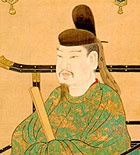Emperor Kammu facts for kids
Quick facts for kids Kammu |
|
|---|---|
| Emperor of Japan | |
 |
|
| Reign | 781–806 |
| Predecessor | Kōnin |
| Successor | Heizei |
| Born | 735 |
| Died | 5 February 806 (aged 70) |
| Burial | Kashiwabara no misasagi (Kyoto) |
Emperor Kammu (桓武天皇, Kammu-tennō), sometimes written as Kanmu, was the 50th emperor of Japan. He ruled from 781 to 806. Kammu was the first emperor of the Heian period in Japanese history.
Contents
Emperor Kammu: A Japanese Ruler
Kammu was an important emperor who helped shape Japan. He is known for moving the country's capital city and for trying to make the government work better. His time as emperor marked the start of a new and famous period in Japanese history called the Heian period.
Early Life and Family
Before he became emperor, his personal name was Yamabe (山部). He was the oldest son of Prince Shirakabe, who later became Emperor Kōnin. Kammu's mother was a descendant of King Muryeong of Baekje, a ruler from an ancient kingdom in Korea.
Kammu had many children, including three sons who later became emperors themselves: Emperor Heizei, Emperor Saga, and Emperor Junna.
Becoming Emperor
Yamabe was the Crown Prince for eight years before he became emperor. This meant he was next in line to rule.
On April 30, 781, Emperor Kōnin decided to step down. His son, Prince Yamabe, then became the new emperor. This was confirmed in special ceremonies. He took on the important role and duties of leading Japan.
Moving Japan's Capital
One of Emperor Kammu's most famous decisions was moving the capital city.
- First, in 784, he moved the capital from Nara (which was called Heijō-kyō) to Nagaoka (Nagaoka-kyō).
- Then, in 794, he moved the capital again. This time, it went to Kyoto (Heian-kyō).
When the capital moved to Kyoto, the emperor's new home was called "Palace of Peace/Tranquility" (平安宮, Heian no Miya). On November 17, 794, the emperor traveled to the new capital in a grand parade. This event officially marked the beginning of the Heian period in Japanese history.
Important Events During His Reign
During his time as emperor, Kammu worked to make the government simpler. He wanted to improve how things were organized and how different parts of the government worked together.
He also appointed Sakanoue no Tamuramaro to lead a military group. This group went on an expedition against the Emishi people, who lived in northern Japan.
Key Dates in Kammu's Life
- 737: Prince Yamabe, who would become Emperor Kammu, was born.
- 773: Yamabe received the title of Crown Prince.
- 781: Emperor Kōnin stepped down, and Kammu became the new emperor.
- 794: The capital was moved to Kyoto, starting the Heian period.
- 806: Kammu died at the age of 70.
What Happened After Kammu's Death?
Emperor Kammu's burial place, called a misasagi, is in Kyoto. It is a special place where people remember and honor him. Emperors are traditionally honored at Shinto shrines at their burial sites.
Eras During Kammu's Time
In Japan, years are often grouped into "era names" (nengō). Kammu's reign covered two main era names:
Images for kids
Related pages
See also
 In Spanish: Kanmu Tennō para niños
In Spanish: Kanmu Tennō para niños


